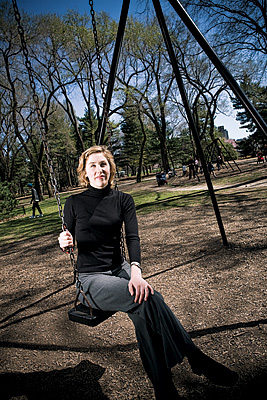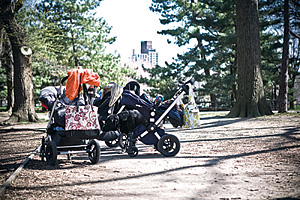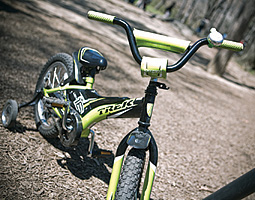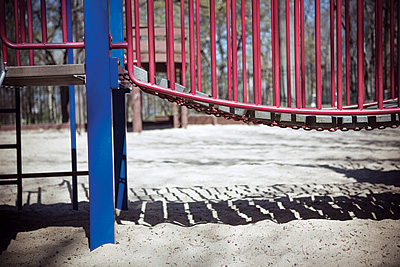My first bed was a dresser drawer, or so my parents say. Like most young couples starting out in Manhattan, they were strapped for both space and cash. Over the next five years, they moved out of the city and had three more children. Although we kids shared bedrooms and clothes, a succession of Christmas-morning photographs documents that we weren't lacking for entertainment: in those old snapshots I can see a rocking horse, a guitar, bicycles, and sleds.

By the standards of 2008, however, it's a miracle we were accepted to nursery school. We had no Baby Mozart CDs or Baby Einstein DVDs to stimulate our brain development (although my father did blast Shostakovich on Saturday mornings). The closest thing to an electronic game that I can remember was a Chatty Cathy doll. When you pulled a cord at the back of her neck, she'd ask, "Will you play with me?" While I remember my mother reading The Wind in the Willows and Dad taking us fishing occasionally, my parents' primary parenting strategy was best characterized as benign neglect. To complain that you were bored was to invite the command: "Go outside; get some fresh air!" We four kids spent most of our time playing cowboys and Indians, building forts, and sneaking out of the yard to catch frogs for pets.
These days, most new parents would hesitate to put their newborn in a hand-me-down crib that might not meet the latest federal safety guidelines, much less a bureau drawer, or so says Pamela Paul, author of the just-published Parenting, Inc.: How We are Sold on $800 Strollers, Fetal Education, Baby Sign Language, Sleeping Coaches, Toddler Couture, and Diaper Wipe Warmers—and What It Means for Our Children. A social critic and journalist who contributes to Time, the Economist, the Washington Post, and other publications, Paul is an astute observer of the commercial pressures on the American family, and this is her third book about that tension. Her first, The Starter Marriage and the Future of Matrimony, looked at the bridal industry and the phenomenon of short-term first marriages. Then came Pornified: How Pornography is Damaging Our Lives, Our Relationships, and Our Families, in which Paul examined the sex industry and the ease with which it addicts men to online porn. Now she has turned her attention to the behemoth industry she calls Big Baby.
One morning this spring, Paul heated matzo ball soup in the cheery yellow kitchen of her Harlem row house. "I vowed that I wouldn't be one of those mothers whose houses revolved around kids, with toys everywhere," the rail-thin Paul said, shaking her head. "But look. There are plastic toys, even in this kitchen!" In truth there weren't that many. Nearby, the living room was empty of toddler clutter; it was spotless, and the contemporary sofas and tribal art showed no traces of little food-stained fingers.
Paul has worked to keep her home this way. She says the impetus for Parenting, Inc. came when she was first pregnant and went to register for shower gifts at a buybuy BABY, a chain of superstores that run up to 60,000 square feet and carry more than 20,000 products. Overwhelmed by the choices before her, Paul had no idea what she would need to care for a newborn. "I mean, what's the difference between a number-one and a number-two nipple?" she jokes now. Did she need a new wardrobe for nursing?
 As she embarked on her own journey to motherhood, Paul began studying the demographic and economic realities facing today's parents and, in turn, the vast amounts of stuff they buy for their babies. "Today the 'mom market' is said to be $1.7 trillion," she writes in Parenting, Inc., "with the toy industry for babies between birth and age two alone generating more than $700 million a year." Paul says contemporary moms and dads have upgraded child rearing to near-professional status and given it a new name: parenting. They approach outfitting a nursery with the same skills they use at work: researching every option online in order to provide their offspring with the absolutely safest and highest-quality car seat, crib mattress, and changing table. Although this may be a laudable impulse, there are signs it has run amok, as parents, guilt-ridden after long hours at the office, eagerly buy more and more products for the offspring whose company they miss all day.
As she embarked on her own journey to motherhood, Paul began studying the demographic and economic realities facing today's parents and, in turn, the vast amounts of stuff they buy for their babies. "Today the 'mom market' is said to be $1.7 trillion," she writes in Parenting, Inc., "with the toy industry for babies between birth and age two alone generating more than $700 million a year." Paul says contemporary moms and dads have upgraded child rearing to near-professional status and given it a new name: parenting. They approach outfitting a nursery with the same skills they use at work: researching every option online in order to provide their offspring with the absolutely safest and highest-quality car seat, crib mattress, and changing table. Although this may be a laudable impulse, there are signs it has run amok, as parents, guilt-ridden after long hours at the office, eagerly buy more and more products for the offspring whose company they miss all day.
This, of course, is great news for the sharks in marketing departments, who have found these hyper-professionalized parents to be suckers for any product that claims to make their loved ones safer, smarter, or happier. As the editor of Parents magazine told Paul, "Parents will do anything to provide for their children." And marketers know it.
Paul says that many of the 20,000 products available at places like buybuy BABY and Babies "R" Us are unnecessary. Despite federal regulation, some are even dangerous—witness last winter's widespread recalls of Chinese-manufactured toys found to have high lead levels. Plus, Paul says, toddler videos and other "edutainment media" are unregulated, freeing companies to make all kinds of unfounded claims; some studies have shown "educational" toys to actually hinder children's brain development and learning. Still other baby products are pointless: as Paul's own pediatrician points out, there is only one truly safe changing table—the floor.
If you haven't outfitted a nursery recently, you'll be shocked by the cost of doing so today. Take strollers. Just a few years ago the cost of a solidly built stroller topped out at around $130. You could shell out $300 for a high-end Maclaren, but strollers weren't exactly a status symbol; no one was ashamed to show up at the tot lot with a mid-priced Graco. On a sunny afternoon this spring, however, New York City's Central Park was abloom not only with daffodils but with funky, high-tech strollers in psychedelic pinks and oranges. These were Bugaboos, the $800 strollers of Parenting, Inc.'s subtitle. A couple of weeks later, Amazon.com invited its customers to preorder a Bugaboo Chameleon (it comes in thirty color choices; you mix and match) for a mere $899.
The Dutch-made Bugaboos don't cost that much in Europe—only in the United States. The story of the Bug's U.S. debut is a case study in creative marketing. Bugaboo's Frog model, named for its top-notch suspension system, made its U.S. debut on Sex in the City when the character Miranda used one to haul her baby around. Demand was primed, and when the Frog became available in January 2002 it instantly became the hottest set of wheels on the sidewalks of Manhattan, Hollywood, and all the flyover states. Madonna had one. So did Gwyneth Paltrow. Why not you? By 2004 a company named Stokke was marketing its own Xtreme stroller, the Xplory; fully loaded, it tops $1,000. These days, Strollers.com lets you choose among nearly 800 models; half of them cost more than $400.
The Bugaboo story, Paul says, embodies two trends in American consumerism. One is new parents' desire to provide their young with the absolute best—and their vulnerability to any product's claim to offer a gentler ride, a better view, or an undisturbed night's sleep.
The second trend is America's infatuation with celebrities and their lifestyles. In the past decade, Paul says, it has been not only acceptable for movie stars to give birth, it's become fashionable. However, you can't expect Madonna or J.Lo. to haul diapers and baby bottles around in a powder-blue bag with Peter Rabbit printed all over it. Spotting an untapped market, Kate Spade and other fashion designers began making trendy, sophisticated bags, and now anyone with $2,120 to spare can sport a Louis Vuitton diaper bag. It's not just the rich who are copying movie stars' baby couture; when People magazine put Angelina Jolie and her newborn, Shiloh, on the cover, readers clamored for the rock-and-roll T-shirt Brad and Angelina's infant wore. Just type "Shiloh T-shirt" into a Google search and see, Paul urged me. Sure enough, that itty-bitty rocker shirt is a global fad.
What's true for strollers, diaper bags, and T-shirts is just as true for cribs, changing tables, and dressers. American families spend more money outfitting nurseries than any other room in the house, Paul reports. While a garden-variety crib that meets current safety standards can be found at Target or Wal-Mart for less than $200, the market for upscale nursery furniture has exploded in the past few years. People magazine gave it a huge boost in 2004, when it reported that Gwyneth Paltrow had ordered a sleek crib ($1,390), dresser ($1,400), and changing table ($1,395) for her baby, Apple, from interior designer David Netto's atelier. (Seeking a wider market, Netto is about to release a bridge line of baby furniture called CUB, hoping to persuade those erstwhile Target customers to spring for a chic $500 crib that turns into a toddler bed and then sofa.)

With all this emphasis on children's possessions and surroundings, Paul writes, "Many Americans have started to fetishize children and family in ways that aren't particularly healthy. Parents today not only photograph and videotape children incessantly but also dress them up and surround them with exquisite objects, spending unconscionable amounts of money adorning them for themselves and others to admire." At the root of this frenzy, one parenting instructor told her, "is a pervasive sense of anxiety and helplessness in a world rife with problems. Obsessing over all these things for our children can seem like the antidote." So we create a soft, cushioned nest for our kids. But the strategy backfires, Paul believes. Instead of teaching our children the skills they need to survive in the real world, we hobble them, creating overindulged little materialists whose self-worth is rooted in their possessions.
Similarly, parents' worries about their children's ability to compete in the academic and career rat races ahead have spawned a whole industry of toys, classes, and videos that purport to make babies smarter. After her first child was born, Paul says she began to worry that she wasn't stimulating the baby enough. She'd dangle toys and the baby would turn away, gazing languidly at her surroundings. While nursing one day, Paul pecked out an anxious e-mail to an old friend from Brown who had raised children. Her friend wrote back, "CALL ME IMMEDIATELY!" Quit worrying, she told Paul: Hold the baby. Feed the baby. Talk to the baby. Let the baby look around her; that's what babies do."
It was an epiphany, says Paul, who looks back on the incident and laughs at her new-mother fretfulness. "Gosh," she says, "and you think about Ben Franklin. He grew up to become a diplomat, a scientist, an inventor, an author, a printer, a statesman—and he didn't have all this stuff. He didn't even have a teddy bear. They hadn't been invented."
Today's young moms and dads fear that their children won't be able to enjoy the advantages that they did themselves, Paul says. Those fears make parents easy prey for products and services that promise to jumpstart their baby's intellectual growth. Anxious moms wear fanny packs so they can play BabyPlus prenatal tapes to their unborn fetuses. Looking for an edge in their newborns' development, parents suspend black-and-white mobiles over their cribs on the theory that infants perceive high-contrast patterns first.
Paul says she and her husband agonized over whether to enroll their seven month old in sign-language classes. A friend's baby was signing, and they'd read that doing so helps infants communicate better and faster and promotes oral language development. They knew their child would be applying to preschool within the next year or so, and the application forms about classes attended by the age of two. Plus, marketers of the signing programs claim their classes add an average of twelve points to a child's IQ score by age eight. Living in Harlem, where good public schools are rare, Paul and her husband hoped those extra points might land their baby a slot in a magnet school so they could afford more children, which they hoped for, since both came from large families. Fortunately, Paul says, she discovered research indicating that the benefits of signing were not clear; in fact, some suggested that signing babies were actually worse off than their merely chatty counterparts.
Eager to pad their kids' preschool résumés, parents race their toddlers from one activity to the next. The result, Paul says, is overscheduled kids who think the world revolves around them and who can't deal with unstructured time. Without free time, she insists, children can't do the real work of childhood: to create their own play and thereby stretch their imaginations.
 Among the prime culprits robbing children of creativity, Paul says, are "educational" toys. Ever since the Tickle Me Elmo doll captivated children and parents with its interactive design, similarly "smart" toys (those able to respond to a child's input) have flooded the market. In 2000 the laptop-like LeapPad was the best-selling toy in the United States. Two years later the company was the year's most successful IPO, and in 2004 it boasted sales of $640.3 million. Sales of educational toys are expected to reach $5.5 billion by 2010, Paul says.
Among the prime culprits robbing children of creativity, Paul says, are "educational" toys. Ever since the Tickle Me Elmo doll captivated children and parents with its interactive design, similarly "smart" toys (those able to respond to a child's input) have flooded the market. In 2000 the laptop-like LeapPad was the best-selling toy in the United States. Two years later the company was the year's most successful IPO, and in 2004 it boasted sales of $640.3 million. Sales of educational toys are expected to reach $5.5 billion by 2010, Paul says.
Still, she reports, a two-year study funded by the University of Stirling, in Scotland, found that educational electronic toys are no more effective at developing literacy and number skills than traditional toys and teaching methods. Paul quotes Diane Levin, a child development specialist at Wheelock College in Massachusetts, who laments the recent proliferation of what she calls bad toys: "Toys with batteries and buttons. Toys that tell children what to do. Toys that program children's play." Educational toys, Levin told Paul, "not only fail to teach children but make raising infants and toddlers 'harder, more confusing, and more insecurity producing.'"
Instead of encouraging children's imagination and risk-taking, electronic toys stifle it, breeding passivity and consumerism, Paul says. She reports that the average American child receives seventy new toys each year, and that the U.S., "with 4 percent of the world's children, consumes 40 percent of the world's toys." MIT cognitive and linguistic science professor Laura Schulz tells Paul that children who play with lots of "smart" toys "become passive absorbers. Instead of honing their ability to focus, they develop impatience; instead of learning creativity, they learn how to behave like unskilled workers on a factory line."
Creativity is not a skill to be taken lightly, Paul writes. It's the skill that underlies intellectual flexibility and adaptability, which are essential to critical thinking. And critical thinking is a key ability in a democratic society.
Even though Paul's research for the book and her writing about child rearing for Time have brought her a deluge of every imaginable toy or video, her house holds no electronic toys. Instead, Paul pulls from a bookshelf a vintage Fisher-Price farm set that she purchased on e-Bay. "I had this when I was a child," she says fondly.
Ironically, built into the wall of Paul's family room is an enormous built-in television screen. "It came with the house," Paul says sheepishly, but she and her husband don't turn it on until after lights out.
Their ban includes "smart videos," such as those made by Baby Einstein, which purport to teach babies reading and math skills, basic science, and even, in some cases, religion. Videos and DVDs for babies (infant development media, marketers call them) made up a $4.8 billion market in 2004, Paul says, and it's still growing.
With no federal regulation, many of the companies selling these media make claims that have little, if any, scientific support. The manufacturers of foreign-language videos and DVDs, for example, would have parents believe that children must be within a critical window of brain development—before age three—to pick up another language. But that's just not so, Paul says; even adults can learn French. Plus, she says, to learn another language, children need to be around a live person who speaks that language, as a University of Washington study has demonstrated.
"The best thing you can say about edutainment is that it's a waste of money," Berkeley psychology professor Alison Gopnik told Paul. In the final analysis, Paul concludes, "Babies learn much more important, complicated things by crawling around and interacting with the people around them."
Of course, most families can't afford all this stuff. The cost of raising children is rising much faster than parents' salaries. Over the past decade, household earnings rose just 24 percent while the cost of raising children jumped 66 percent, Paul reports. The U.S. Department of Agriculture, which monitors that cost, released new figures in April estimating that a two-parent family earning between $45,800 and $77,100 a year will spend an average of $204,060 to raise a child to age seventeen. Paul believes that number is far too low. When, in 2007, the Wall Street Journal added in costs such as tutoring and sports equipment—common expenses in middle-class families—it came up with a cost of $800,000 to $1.6 million. And that's before college.
"Again and again and again," Paul writes in Parenting, Inc., "couples in their midtwenties to midthirties say they don't feel they can afford to have kids until at least one of them is making a six-figure salary."
Paul and her husband know this dilemma well. "We hardly have unlimited resources," she wrote in the Washington Post this April, "but we're still planning to go forth and multiply in the big city. The way we figure it, one day our children will be grateful for what we didn't give them—and what we did for them instead."
Charlotte Bruce Harvey is the BAM's managing editor.
Photos by Jared Castaldi.




